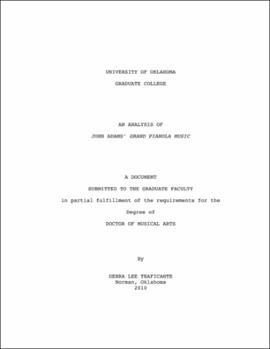| dc.contributor.advisor | Wakefield, William K | |
| dc.creator | Traficante, Debra | |
| dc.date.accessioned | 2019-04-27T21:41:31Z | |
| dc.date.available | 2019-04-27T21:41:31Z | |
| dc.date.issued | 2010 | |
| dc.identifier | 9993120302042 | |
| dc.identifier.uri | https://hdl.handle.net/11244/319358 | |
| dc.description.abstract | Grand Pianola Music, composed in 1982 by John Adams, was written for pairs of winds, extended percussion, three female vocalists, and two pianos. Due to critic and audience disapproval, by way of booing after its 1983 east-coast premiere at Avery Fisher Hall in New York City, the work receded into the shadows of the composer's output. After reflecting on the work for more than ten years, Adams determined that Grand Pianola Music is representative of his true musical-self and was worthy of performance. Adams conducted and recorded the work with the London Sinfonietta in 1993, finally converting many cynics that existed ten years earlier. | |
| dc.description.abstract | This document includes biographical data and a formal analysis informed by dynamic and textural growth and decay. Dynamic and texture charts for each movement, and a dynamic chart of the entire work, provide a concise yet detailed picture of the high and low architectural points. The texture chart is also a valuable organization tool for managing personnel during rehearsals. While other compositional elements, such as tonality, rhythm, and timbre contribute to form, the formal architecture in this study is presented from the perspective of dynamics and texture. | |
| dc.format.extent | 184 pages | |
| dc.format.medium | application.pdf | |
| dc.language | en_US | |
| dc.relation.requires | Adobe Acrobat Reader | |
| dc.subject | Music | |
| dc.title | An Analysis of John Adams' Grand Pianola Music | |
| dc.type | text | |
| dc.type | document | |
| dc.thesis.degree | D.M.A. | |
| ou.group | Weitzenhoffer Family College of Fine Arts::School of Music | |
